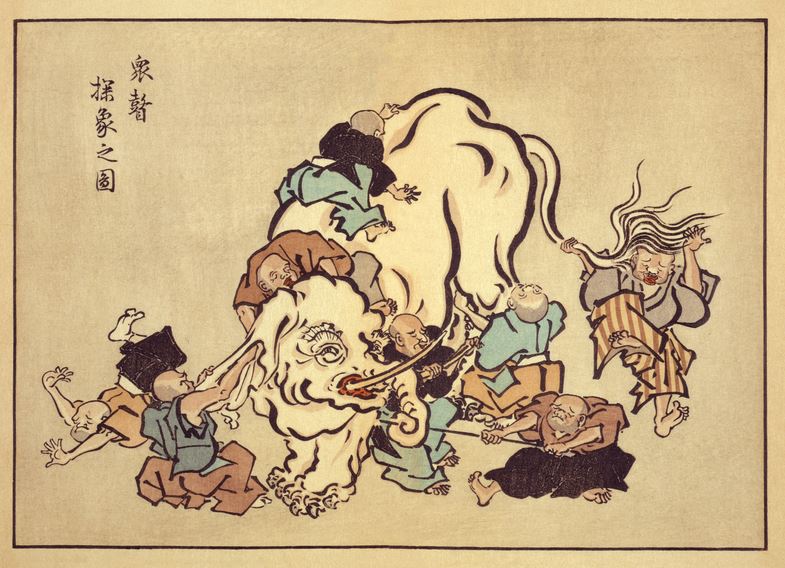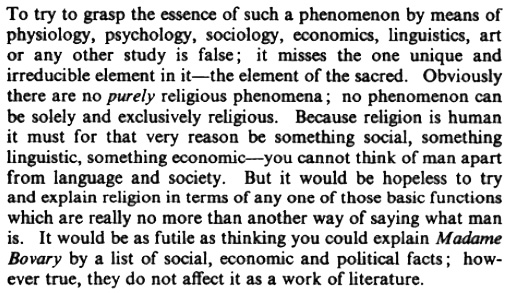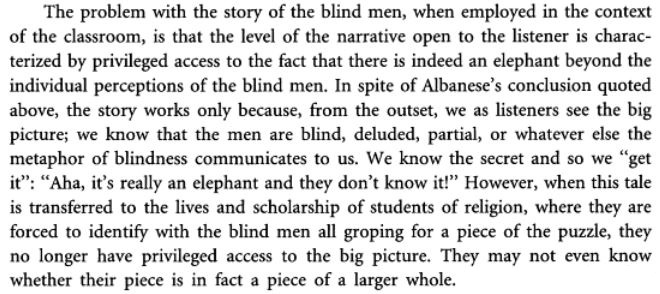 This is an installment in an ongoing series on the American Academy of Religion’s recently released draft statement on research responsibilities.
This is an installment in an ongoing series on the American Academy of Religion’s recently released draft statement on research responsibilities.
An index of the complete series (updated as each
article is posted) can be found here.
Hanabusa Itchō‘s (d. 1724) print of the well-known parable of the blindmen and the elephant seemed to me a fitting image to open this commentary on the sixth bullet point in this document.
It reads:
 I won’t quibble as to why the word “theoretical” isn’t bolded, but I tend to think it’s rather significant and not just a copyediting oversight; for “theory” is still (to borrow a phrase of my own, from an earlier but, I think, still relevant, time) a four-lettered word for many in our field, inasmuch as it implies, for them, determining the cause of religion as opposed to interpreting its enduring and deeply personal meaning. And, while many think that the era is long past when religion was claimed by scholars to be unique and unexplainable (what is meant by a Latin term we used to see a lot in the literature: sui generis), the still widespread commitment to seeing religion as a site where transcendent meaning is manifested (or embodied, as some now prefer to say), as opposed to seeing what we call religion to be a secondary phenomenon that results from some other mundane aspect of historical existence, tells me that not much has changed in our field.
I won’t quibble as to why the word “theoretical” isn’t bolded, but I tend to think it’s rather significant and not just a copyediting oversight; for “theory” is still (to borrow a phrase of my own, from an earlier but, I think, still relevant, time) a four-lettered word for many in our field, inasmuch as it implies, for them, determining the cause of religion as opposed to interpreting its enduring and deeply personal meaning. And, while many think that the era is long past when religion was claimed by scholars to be unique and unexplainable (what is meant by a Latin term we used to see a lot in the literature: sui generis), the still widespread commitment to seeing religion as a site where transcendent meaning is manifested (or embodied, as some now prefer to say), as opposed to seeing what we call religion to be a secondary phenomenon that results from some other mundane aspect of historical existence, tells me that not much has changed in our field.
After all, it’s not insignificant that the word “interpretation” appears in this draft document (twice, in fact, if you count the preamble) while the effort to explain religion is wholly absent from it. That our field could be considered to owe its very existence to a variety of late-19th century scholars who tried to do just that — i.e., explain the ordinary causes of being religious — makes this absence all the more glaring.
But like I said, I won’t quibble about that; instead, my interest is mainly drawn to this notion of methodological pluralism and the respect we’re told that we each ought to show to the (predictably, perhaps) undefined variety of approaches that supposedly comprises the study of religion today.
And here we come back to the story of the blindmen and the elephant — an early version of which is found in part of the Pali Canon known as the Udana.
Despite now being a favorite story of the religious pluralist (open up any world religions textbook and there’s a good chance you’ll find the story cited approvingly somewhere in its pages, given that its modern variants so nicely illustrate the eternal unity that lurks beneath the diversity of contingent viewpoints [which, by the way, is hardly what’s going on in ancient Pali versions of the story]), it’s also a fitting metaphor for what the field has become as well — correction, what it always was; for I’ve argued in the past that interdisciplinarity was where the much-critiqued approach to religion as sui generis went in the 1990s, to lick its wounds and reorganize. For while few now seem to want to mount a defense of religion as being unique and uncaused (“No one reads Eliade anymore,” people regularly tell me, as if we’ve somehow left that past behind us) many instead seem keen to argue that religion is such a complicated, diverse thing that we need many different approaches to study it.
And voila: methodological pluralism defines the field; after all, as the bullet point reads, that’s what distinguishes us (i.e., sets us apart) from all others.
To put it another way, don’t think you’ve exhausted religion just because you’ve studied it sociologically or psychologically…. Or, as Eliade — yes, I’m quoting Elaide — wrote in the foreword to his 1949 book, Patterns in Comparative Religion (p. xvii):
 No one blindman’s assessment is sufficient, then, since the whole transcends the of the particulars that we can see, hear, feel, etc. This is why we need such a big tent, to contain all the people groping not just the ears but the tail and the trunk and the tusks and the legs and the…. Well, you get the idea.
No one blindman’s assessment is sufficient, then, since the whole transcends the of the particulars that we can see, hear, feel, etc. This is why we need such a big tent, to contain all the people groping not just the ears but the tail and the trunk and the tusks and the legs and the…. Well, you get the idea.
And so perhaps this is why “methodological pluralism” is written in bolded text (you just knew I couldn’t let that one go, right?), for as it is often used in the field today it is a way of sounding rigorously empirical while yet presupposing one’s object of study to be transcendental, deeply meaningful, and thus greater than the sum of its parts. For in this model the elephant in the room pre-exists the measures we use to define and study it, for that’s how we somehow know that, say, a gendered analysis isn’t sufficient no matter how important we think it might be to add it to the mix. For there’s always more to this thing called religion (as I’ve argued before, just look at the unending nature of the “religion and…” segment of the AAR’s annual program) — and so it can’t be reduced to any one method of study, which means that it cannot be explained and that it has no cause.
Instead, it just endures.
And that’s how the approach to religion as sui generis works its way back into the field, but in a new guise — such that it never really left. Our field is, the committee reminds us, distinguished, after all…, as if no other field has multiple methods up and running and alternative theories….
What’s more, we now also see why we who are the grasping, sightless monks, must be respectful of those with whom we disagree, offering only constructive criticism (whatever that is) — not because of a sense of professionalism but, instead, because of the many-splendored thing that is religion, for not only who are we to think that our approach has exhausted the object of study but who are we to think that we can go it alone, without the help of the others who are feeling a different part of the object that we don’t even see, given our anthropological or historical or literary blinders.
And so we arrive at the curious position that no one who studies religion can be wrong in the conclusions they reach (judge not, least be judged…?) — and so I’d argue that our main professional association is modeled on interreligious dialogue inasmuch, as it “welcomes all disciplined reflection on religion” (as phrased in its mission statement, already examined here).
But what’s the problem with this understanding of the field?
In Manufacturing Religion (1997: 110), at a much earlier stage of my thinking on all this, I phrased it as follows:
 So let me ask: lacking the privilege of a god’s eye viewpoint, how, precisely, does the committee know that we need many methods to study religion adequately? What are the limits of this plurality (for, failing to define what constitutes “disciplined,” surely not everyone is admitted into this big tent)? And why are not the professional criteria of public evidence and rational argumentation sufficient to govern our scholarly disagreements?
So let me ask: lacking the privilege of a god’s eye viewpoint, how, precisely, does the committee know that we need many methods to study religion adequately? What are the limits of this plurality (for, failing to define what constitutes “disciplined,” surely not everyone is admitted into this big tent)? And why are not the professional criteria of public evidence and rational argumentation sufficient to govern our scholarly disagreements?